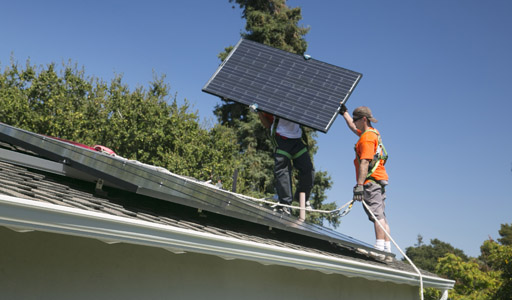Nine East Bay cities have collaborated to help minimize the red tape that intimidates and frustrates some property owners, both residential and commercial, who are considering going solar.

A new streamlined solar permit process creates a uniform set of structural requirements for nine East Bay cities. City officials say not having to prepare city-specific structural reports will save solar installers time, and could lead to savings for property owners. Photo courtesy of Sungevity
By Bill Picture
Published: September, 2013
Nine East Bay cities have collaborated to help minimize the red tape that intimidates and frustrates some property owners, both residential and commercial, who are considering going solar.
Prospective solar customers in each of the participating cities—Albany, Alameda, Berkeley, El Cerrito, Emeryville, Hayward, Oakland, Richmond and San Leandro—will still have to secure a permit from their nearest city hall, but the process has been standardized so that the permitting agencies in all nine cities will use the same "structural checklist" when determining whether to approve or deny a project.
The checklist takes into account such factors as a building’s roof slope and rafter size, and allows city officials to assess accurately and confidently the structural soundness of a proposed installation. "The change will be felt most, at least initially, by the companies that install solar panels," said Neal DeSnoo, energy manager for the City of Berkeley.
Different city, different hoops
Until now, the process of securing a solar permit varied so widely from one municipality to the next that a contractor could find itself jumping through drastically different sets of hoops for nearly identical projects in neighboring cities.
"The solar installers essentially had to have nine different templates—one for each city," DeSnoo said. "Now, there’s a uniform set of guidelines. The process has been made more predictable for the solar companies."
The time spent navigating the bureaucracy of a potential solar customer’s local government is reflected in solar companies’ prices. DeSnoo said that, logically, saving the solar companies’ time and hassle should eventually save their customers money.
Most notably, the new streamlined solar permitting process will drastically reduce the need for solar installers to hire a third-party structural engineer.
"That’s been the case for a lot of older housing stock that doesn’t meet current city codes," DeSnoo said. "And it’s very expensive." A structural engineer working on a project can add up to $3,500 to a solar system’s price tag.
What’s now been developed is a system for determining in many cases without the help of an outside party whether a roof not built to current code is sturdy enough to carry solar panels. "This will help the companies reduce their costs, which hopefully will result in reduced costs for consumers," DeSnoo said.
And that’s important, he added, because cost is still a major determining factor for many property owners considering making the switch to solar energy. "Technology is driving down the cost of the equipment, which is making the permitting costs and filing fees seem proportionately larger."
If Richmond Mayor Gayle McLaughlin and Councilmember Tom Butt have their way, Richmond will be the first city to slash its fee for obtaining a solar permit. McLaughlin and Butt plan to propose reducing the city’s solar permit fee from $615 to $100 at the Richmond City Council’s September 10 meeting.
At present, Richmond’s fee is the highest of the nine cities participating in the new standardized permit process. If the proposed fee reduction is approved, a permit will cost the same in Richmond as it does in El Cerrito, which is currently the cheapest of the nine cities.
Time is money
Six of the nine cities will now be offering same-day, over-the-counter permitting, with the remaining three cities now promising permits in-hand within three to seven business days. Until now, the process could take months. So even if permit fees weren’t reduced, if time really is money, then time saved is money saved.
"In Germany, there’s a two-page form to get a solar permit," said Sungevity CEO Andrew Birch, at an event last month announcing the rollout of the new and improved solar permitting process. "But in the United States, each city has different rules. Our customers typically experience a three- to four-month wait from the time they sign up to go solar to when they get the system installed. Standardizing the process will remove 25 percent of that time delay."
Sungevity is a Berkeley-based solar installer with more than 300 employees. The company serves customers throughout the United States, as well as the Netherlands and Australia. Birch theorized that making it easier for someone to go solar may increase the likelihood of them encouraging friends and neighbors to make the switch. And as the demand for solar increases, so too would the number of green jobs.
All nine of the participating cities are members of the East Bay Green Corridor, a collaboration between the cities, UC Berkeley, Lawrence Livermore National Laboratory, CSU East Bay and Peralta Community College District. The East Bay Green Corridor was established in 2007 to promote the region as a green tech hub and drive green job development.
"It’s a body that convenes with the intent of identifying and pursuing policies that support green industries and improve the quality of life for people who live and work here," DeSnoo said. "So what this new permitting process could do for the local economy, let alone the environment, is really exciting."
For more information on the East Bay Green Corridor, visit www.ebgreencorridor.org.

